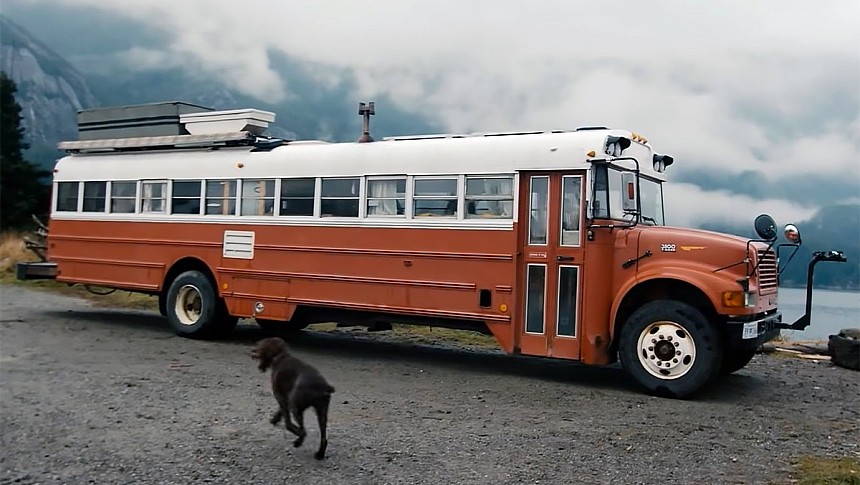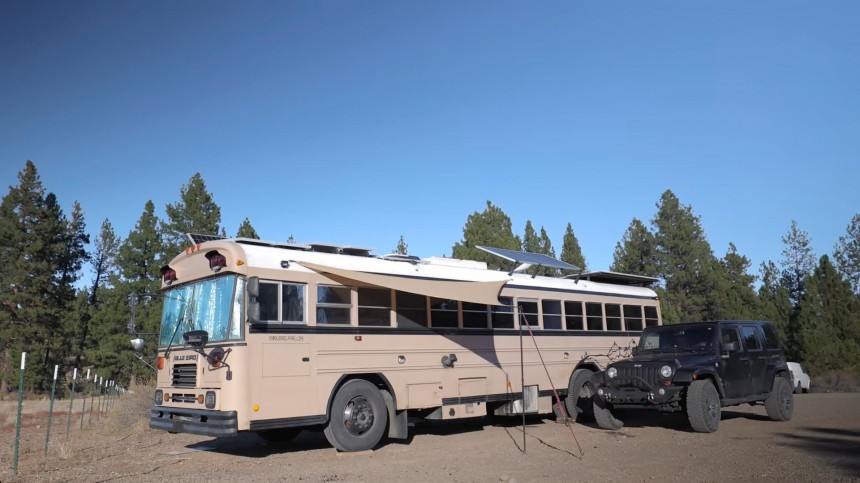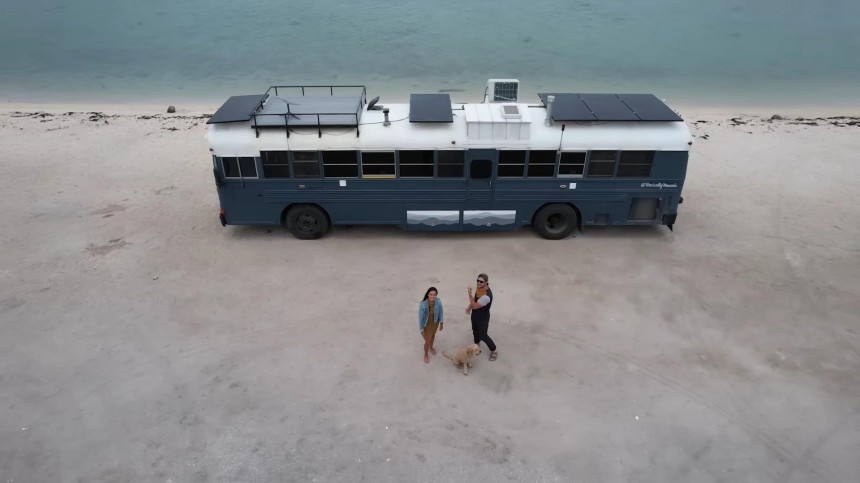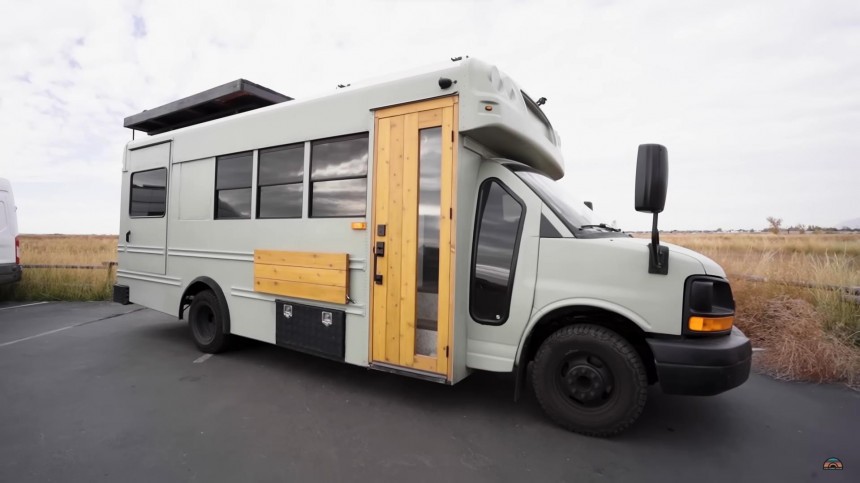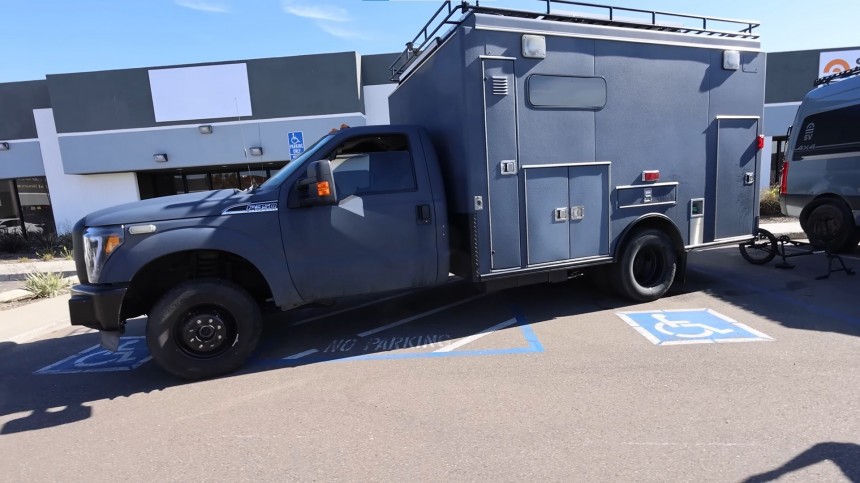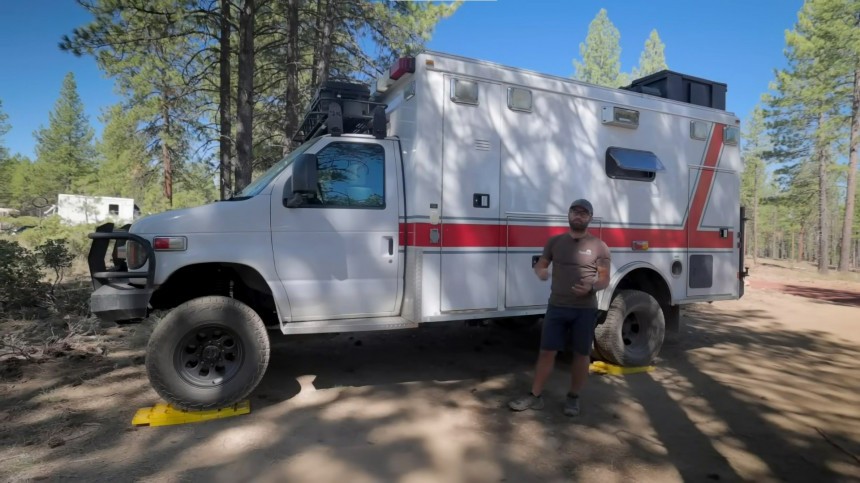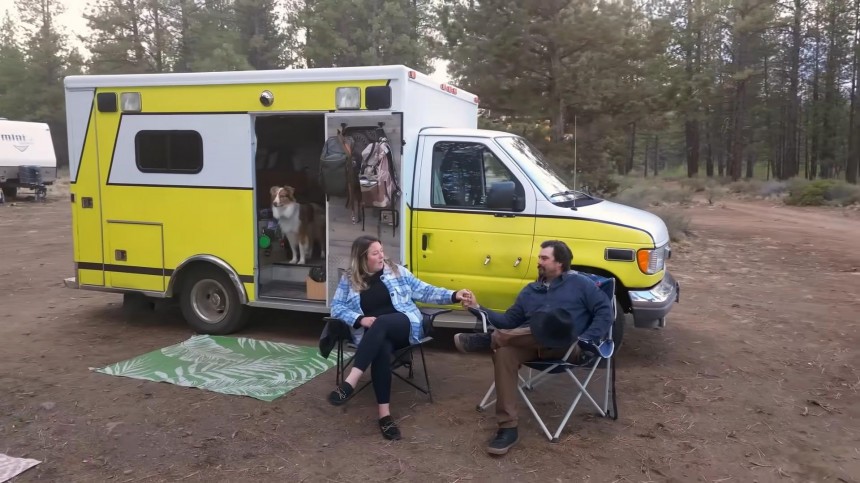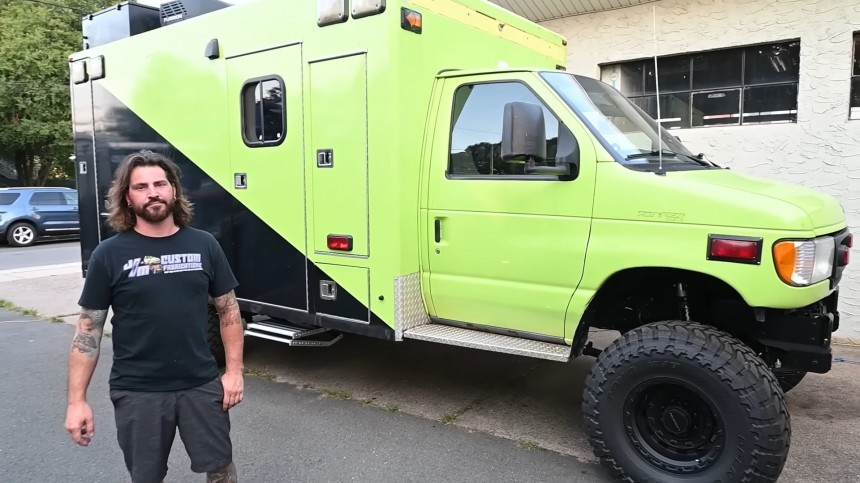Camper conversions are becoming increasingly popular, especially since remote work is more accessible nowadays than ever. Vans are usually the first vehicles that come to mind when considering camper conversions. However, skoolies and ambulances can also be turned into tiny homes on wheels. That's what I will discuss in today's article.
A few days ago, I wrote about the five types of camper vans that can be converted into mobile homes. Of course, each has its pros and cons. But I'm sure some of you aren't satisfied with the perks camper vans offer, and this article is designed to shed some light on other vehicles that might be better for your needs and wants.
Keep in mind that the longer your bus, the harder it'll be to find places that can service it. Don't be alarmed; most cities have great diesel and truck shops.
The two main choices regarding shape are flat nose and dog-nose. Short buses only come in conventional (dog-nose) body styles, as they're typically truck cutoffs with a fiberglass addition. Flat noses (Transit-style buses) only come in larger-size buses.
Naturally, the type of school byus you buy will directly affect the layout you can integrate. Another key element to take into consideration is wheel wells. You won't have to worry about the front wheel wells in a dog-nose bus, just those at the rear.
The dog-nose is the classic school bus, the one renowned and instantly recognizable throughout the world. Here are some of its pros and cons. On the positive side, you get a big approach angle, only two wheel wells in the rear to deal with, easy access to the engine bay, and access to the rear for a garage.
On the other hand, dog-nose school buses have big departure angles, less usable conversion space (compared to flat-nose buses), and reduced visibility.
When it comes to flat-nose buses, you can split them into two categories: front engine and rear engine. Rear-engine school buses generally have a larger engine, which is only found in full-length vehicles.
Front engine flat nose skoolies have more space compared to conventional skoolies, better visibility, and look more like a Class A RV. Moreover, their shorter wheelbases make them easier to turn and handle. On the other hand, they have worse approach angles than dog-nose buses, their engines are hot and loud and might bother the drivers (as they're right beside them), and maintenance can get messy.
And finally, we have the rear engine flat-nose skoolies, also known as pushers. As I mentioned, they can sport a bigger engine, such as the 8.3-liter Cummins. They're pretty quiet for driving and have underbelly storage, good visibility, and longer wheelbases, which translates to a smoother ride. More importantly, they offer more space to create a dreamy interior.
At the same time, you don't have room for a rear garage. What's more, you get lower ground clearance due to underbelly storage, four-wheel wells to build around, and a worse approach angle compared to a conventional bus.
While there are pros and cons for each type of bus, they're not really dealbreakers. What I mean is that I won't suggest avoiding a specific type, as it ultimately boils down to your exact needs.
So, what are other things to consider when building a skoolie? Well, you need to figure out your wants and needs. More specifically, think of the features, rooms, and amenities you'll want to install. The immense space inside skoolies is one of their biggest perks.
Most skoolies I've covered (and trust me, I've written many articles about them) have the following features: big and well-equipped kitchens, wet bathrooms (generally devised into two parts, a shower, and a toilet/sink area), a full-size bed (usually at the rear), couches, lounges, various other seating options, washer/dryers, and entertainment areas.
Regarding utilities, most skoolies feature water tanks (and they're typically pretty big, enabling off-grid travel), wood stoves, diesel heaters, A/Cs, and powerful electrical systems. By the way, the larger a skoolies is, the more room you have on the roof to fit more solar panels.
One of the major upsides of converting a school bus is cost. So, how much does it cost to convert a used school bus? Most people who converted school buses that I've written about spent around $30,000 to $40,000 for the conversion, including the base vehicle. But let me break down the costs.
A used bus can cost anywhere between $2,500 and $7,500. Some used buses that are in great shape and have really good specs might be in the $20,000 - $25,000 range. Of course, the higher you go, the better the chance of the vehicle being in a better condition. My suggestion is not to skimp on the base vehicle because of a few thousand dollars because you might end up paying that or even much more after you realize the vehicle will need significant repairs. Oh, and always watch out for rust.
Even though used buses are so cheap, instead of paying financially, you'll end up paying with blood, sweat, and tears. Because they're old and large, there are many things to take care of, such as mechanical issues, insulation, hole sealing, roof raises, and more. Then, how much you invest in its conversion depends on what your needs are.
What I mentioned above referred to a DIY conversion. But not everybody has the tools and knowledge to carry out such a conversion. If you employ a specialized company to make the conversion, you'll probably end up paying more.
There’s also the topic of gas mileage. Like any large RV, a skoolie will drink lots of diesel. On average, a school bus conversion will get around 7 to 10 MPG, and that’s for a diesel engine and if we’re talking highway mileage.
To sum it up, here are some pros and cons for skoolie conversions.
Ambulances can be an exciting alternative if you're looking for something different than a typical cargo van build. Lately, they've also become pretty popular for camper conversions, and for a good reason.
Just like how I did with skoolies, I'd like to first list the common models and differences between them. We can split ambulances into three types.
Type 2 ambulances are constructed on a commercial van chassis, which provides superior fuel efficiency than Type 1 vehicles. Their compact structure makes them more maneuverable and easier to park, but you'll have to sacrifice on space and storage compared to Types 1 and 3. A common vehicle used here is the Chevrolet G3500, which often sports a 6.0-liter gasoline engine.
Type 3 ambulances are made on a cutaway van chassis. As a rule of thumb, they provide the most extensive living spaces, making them ideal for camper conversions. However, they might not be as powerful and durable as Type 1. Think of the Ford E-350 and E-450 models, famous for their robust nature and availability of spare parts. These models are also used for Type 2 ambulances.
So why are they so popular for conversions? Ambulances are built for durability and reliability, as they're designed to save lives. They're meant to respond in all kinds of conditions, from urban environments to remote rural locations. Moreover, they can handle a lot of wear and tear, much better than cargo vans and other types of vehicles.
Just like skoolies, ambulances are typically well-maintained, perhaps even more than school buses. They undergo routine servicing and maintenance, so there's a high chance you can find a vehicle in good condition.
They're unique and different and always catch the eye of bystanders. If you're into the extra attention, they're good choices. However, if you want a stealthy build, there's no way you can achieve that with an ambulance. Inconspicuous campers allow you to camper pretty much wherever you want, and there's the added bonus of security from ill-intended people trying to break into your mobile home.
Ambulances come with existing storage solutions. They feature multiple compartments, including cupboards and cabinets both inside and outside, designed to house the many medical tools and gear needed to save lives. This can be both a blessing and a curse. That's because you can integrate the existing compartments into the camper build, thus removing the need to devise custom-built storage spots, saving you time and money. However, if you're not satisfied with the existing build, removing all the features will be a hassle, given their sturdiness. This also applies to installing new features, such as windows or vents.
Another key factor to consider is insulation. Unlike cargo vans, ambulances are generally well-insulated to keep patients comfortable regardless of the weather conditions. This can come in handy in a camper conversion, in which proper insulation is a must whether you travel in hot or cold environments.
All ambulances come pre-wired so they can support the heavy electrical loads of medical tools and gear. Their sophisticated electrical systems comprise high-capacity alternators and multiple battery systems, among other components.
The ease of modification for these electrical systems varies depending on the exact model. Some will be extremely challenging to modify, especially if you do it by yourself, while others might be easier to transform for off-grid camping. Any proper camper needs electrical systems, so there's no way around this.
And lastly, one attractive detail regarding ambulance camper conversion is affordability. Ambulances are cheaper than purpose-built camper vans or RVs.
Let me balance things out by focusing the following part on the cons of converting an ambulance. First, you'll need to strip and clean the ambulance, which involves potential health hazards. Furthermore, the process is typically labor-intensive and time-consuming.
Even with all the servicing and maintenance, ambulances' high mileage and long idling hours can lead to mechanical issues, which means more money spent on repairs and replacements. To be frank, it's a gamble, and if you're interested in making an ambulance camper conversion, you'll have to assume this risk.
Then, there's the legal side of stuff. Just like with skoolies, insuring ambulances can sometimes be difficult. The solution for this is shopping around at various specialist insurance providers. What's more, the private use of an ambulance comes with several legal restrictions. For instance, you must remove lighting options, sirens, and certain colors that hint toward the vehicle's ambulance DNA.
Pros:
Cons:
School buses a.k.a. Skoolies
A skoolie is a school bus that has been retired and decommissioned from use on a school route and then transformed into a tiny home on wheels. Converting school buses into recreational vehicles isn't a new idea. But lately, they've become way more trendy and have become one of the most popular vehicles to convert into mobile homes.Types of Skoolies
Before we delve into skoolies' pros and cons, let me explain the types of buses, as they come in several shapes and sizes. Regarding size, the total bumper-to-bumper length of a short bus is 20 to 25 feet (6.1 to 7.6 meters). Moreover, a mid-size one measures 25 to 35 feet (7.6 to 10.7 meters), while a full-length one has 35 to 40 feet (10.7 to 12.2 meters).Keep in mind that the longer your bus, the harder it'll be to find places that can service it. Don't be alarmed; most cities have great diesel and truck shops.
The two main choices regarding shape are flat nose and dog-nose. Short buses only come in conventional (dog-nose) body styles, as they're typically truck cutoffs with a fiberglass addition. Flat noses (Transit-style buses) only come in larger-size buses.
The dog-nose is the classic school bus, the one renowned and instantly recognizable throughout the world. Here are some of its pros and cons. On the positive side, you get a big approach angle, only two wheel wells in the rear to deal with, easy access to the engine bay, and access to the rear for a garage.
On the other hand, dog-nose school buses have big departure angles, less usable conversion space (compared to flat-nose buses), and reduced visibility.
When it comes to flat-nose buses, you can split them into two categories: front engine and rear engine. Rear-engine school buses generally have a larger engine, which is only found in full-length vehicles.
Front engine flat nose skoolies have more space compared to conventional skoolies, better visibility, and look more like a Class A RV. Moreover, their shorter wheelbases make them easier to turn and handle. On the other hand, they have worse approach angles than dog-nose buses, their engines are hot and loud and might bother the drivers (as they're right beside them), and maintenance can get messy.
And finally, we have the rear engine flat-nose skoolies, also known as pushers. As I mentioned, they can sport a bigger engine, such as the 8.3-liter Cummins. They're pretty quiet for driving and have underbelly storage, good visibility, and longer wheelbases, which translates to a smoother ride. More importantly, they offer more space to create a dreamy interior.
At the same time, you don't have room for a rear garage. What's more, you get lower ground clearance due to underbelly storage, four-wheel wells to build around, and a worse approach angle compared to a conventional bus.
While there are pros and cons for each type of bus, they're not really dealbreakers. What I mean is that I won't suggest avoiding a specific type, as it ultimately boils down to your exact needs.
Most skoolies I've covered (and trust me, I've written many articles about them) have the following features: big and well-equipped kitchens, wet bathrooms (generally devised into two parts, a shower, and a toilet/sink area), a full-size bed (usually at the rear), couches, lounges, various other seating options, washer/dryers, and entertainment areas.
Regarding utilities, most skoolies feature water tanks (and they're typically pretty big, enabling off-grid travel), wood stoves, diesel heaters, A/Cs, and powerful electrical systems. By the way, the larger a skoolies is, the more room you have on the roof to fit more solar panels.
One of the major upsides of converting a school bus is cost. So, how much does it cost to convert a used school bus? Most people who converted school buses that I've written about spent around $30,000 to $40,000 for the conversion, including the base vehicle. But let me break down the costs.
A used bus can cost anywhere between $2,500 and $7,500. Some used buses that are in great shape and have really good specs might be in the $20,000 - $25,000 range. Of course, the higher you go, the better the chance of the vehicle being in a better condition. My suggestion is not to skimp on the base vehicle because of a few thousand dollars because you might end up paying that or even much more after you realize the vehicle will need significant repairs. Oh, and always watch out for rust.
Even though used buses are so cheap, instead of paying financially, you'll end up paying with blood, sweat, and tears. Because they're old and large, there are many things to take care of, such as mechanical issues, insulation, hole sealing, roof raises, and more. Then, how much you invest in its conversion depends on what your needs are.
What I mentioned above referred to a DIY conversion. But not everybody has the tools and knowledge to carry out such a conversion. If you employ a specialized company to make the conversion, you'll probably end up paying more.
To sum it up, here are some pros and cons for skoolie conversions.
Pros:
- They offer a ton of space to create a fully-equipped interior
- Very durable
- Generally well-maintained, with routine inspections and maintenance while operating for schools
- Very affordable compared to other types of base vehicles
- Countless Customization Options
Cons:
- Difficult and time-consuming to DIY-convert
- Difficult to license and insure
- Not all campgrounds allow access
- Potential project-ending mechanical issues
- Poor gas mileage
Skoolie Examples
I want to end things by showing you two of the coolest skoolies I’ve written about. This one was built with a mind-blowingly low budget of $10,000 (including the base vehicle), proving that with some help from friends and family and with lots of research, you can build a skoolie for very low bucks. The other one is this school bus turned into an off-grid-capable masterpiece on wheels.Ambulances
Just like how I did with skoolies, I'd like to first list the common models and differences between them. We can split ambulances into three types.
Types of Ambulances
Type 1 ambulances are built on a heavy-duty pickup truck chassis. Think of the Ford F-350 and F-450 models – these pickup-based models are favored for their durability and availability of spare parts. Moreover, you can get your hands on factory-available 4x4 options.Type 2 ambulances are constructed on a commercial van chassis, which provides superior fuel efficiency than Type 1 vehicles. Their compact structure makes them more maneuverable and easier to park, but you'll have to sacrifice on space and storage compared to Types 1 and 3. A common vehicle used here is the Chevrolet G3500, which often sports a 6.0-liter gasoline engine.
Type 3 ambulances are made on a cutaway van chassis. As a rule of thumb, they provide the most extensive living spaces, making them ideal for camper conversions. However, they might not be as powerful and durable as Type 1. Think of the Ford E-350 and E-450 models, famous for their robust nature and availability of spare parts. These models are also used for Type 2 ambulances.
Just like skoolies, ambulances are typically well-maintained, perhaps even more than school buses. They undergo routine servicing and maintenance, so there's a high chance you can find a vehicle in good condition.
They're unique and different and always catch the eye of bystanders. If you're into the extra attention, they're good choices. However, if you want a stealthy build, there's no way you can achieve that with an ambulance. Inconspicuous campers allow you to camper pretty much wherever you want, and there's the added bonus of security from ill-intended people trying to break into your mobile home.
Ambulances come with existing storage solutions. They feature multiple compartments, including cupboards and cabinets both inside and outside, designed to house the many medical tools and gear needed to save lives. This can be both a blessing and a curse. That's because you can integrate the existing compartments into the camper build, thus removing the need to devise custom-built storage spots, saving you time and money. However, if you're not satisfied with the existing build, removing all the features will be a hassle, given their sturdiness. This also applies to installing new features, such as windows or vents.
Another key factor to consider is insulation. Unlike cargo vans, ambulances are generally well-insulated to keep patients comfortable regardless of the weather conditions. This can come in handy in a camper conversion, in which proper insulation is a must whether you travel in hot or cold environments.
The ease of modification for these electrical systems varies depending on the exact model. Some will be extremely challenging to modify, especially if you do it by yourself, while others might be easier to transform for off-grid camping. Any proper camper needs electrical systems, so there's no way around this.
And lastly, one attractive detail regarding ambulance camper conversion is affordability. Ambulances are cheaper than purpose-built camper vans or RVs.
Let me balance things out by focusing the following part on the cons of converting an ambulance. First, you'll need to strip and clean the ambulance, which involves potential health hazards. Furthermore, the process is typically labor-intensive and time-consuming.
Even with all the servicing and maintenance, ambulances' high mileage and long idling hours can lead to mechanical issues, which means more money spent on repairs and replacements. To be frank, it's a gamble, and if you're interested in making an ambulance camper conversion, you'll have to assume this risk.
Then, there's the legal side of stuff. Just like with skoolies, insuring ambulances can sometimes be difficult. The solution for this is shopping around at various specialist insurance providers. What's more, the private use of an ambulance comes with several legal restrictions. For instance, you must remove lighting options, sirens, and certain colors that hint toward the vehicle's ambulance DNA.
- Affordable and easy to find
- Unique and eye-catching ride
- Pre-built interior with many storage spaces
- Built to last
Cons:
- High mileage = might come with mechanical issues
- Not stealthy
- A hassle to fully convert
- Legal considerations
